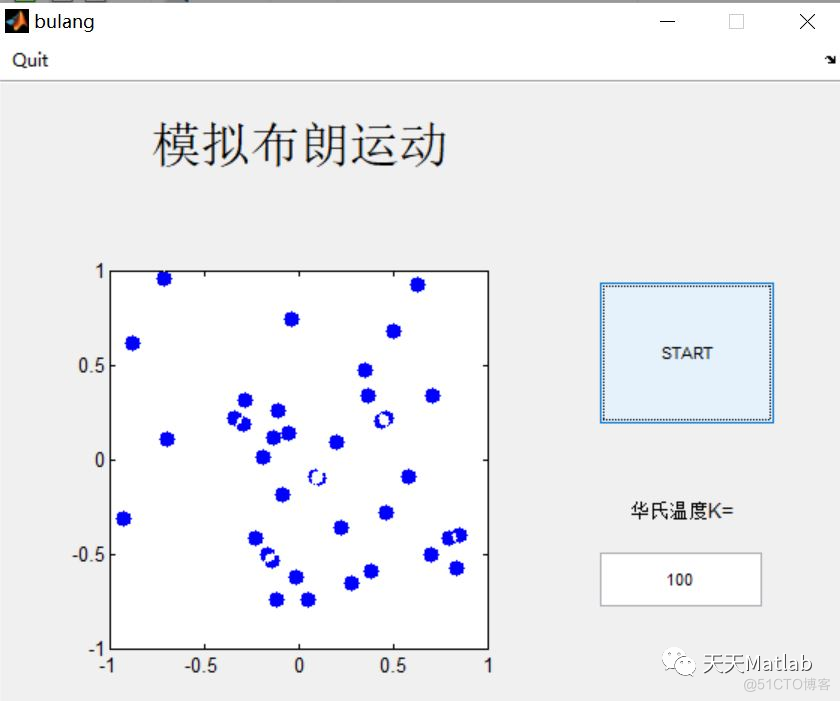1 简介 利用matlab工具模拟了布朗运动测量的实验。通过一正态随机数产生函数模拟从而产生布朗运动步距。在假定粒子所受拖曳力满足斯托克斯关系的情况下,通过拟合多个粒子的均方位
1 简介
利用matlab工具模拟了布朗运动测量的实验。通过一正态随机数产生函数模拟从而产生布朗运动步距。在假定粒子所受拖曳力满足斯托克斯关系的情况下,通过拟合多个粒子的均方位移随时间的变化曲线得到斜率,从而进一步可得出扩散系数和波尔兹曼常数。同时,根据模拟结果也对如何减小实验误差作了分析。
2 完整代码
function varargout = bulang(varargin)% BULANG M-file for bulang.fig
% BULANG, by itself, creates a new BULANG or raises the existing
% singleton*.
%
% H = BULANG returns the handle to a new BULANG or the handle to
% the existing singleton*.
%
% BULANG('CALLBACK',hObject,eventData,handles,...) calls the local
% function named CALLBACK in BULANG.M with the given input arguments.
%
% BULANG('Property','Value',...) creates a new BULANG or raises the
% existing singleton*. Starting from the left, property value pairs are
% applied to the GUI before bulang_OpeningFcn gets called. An
% unrecognized property name or invalid value makes property application
% stop. All inputs are passed to bulang_OpeningFcn via varargin.
%
% *See GUI Options on GUIDE's Tools menu. Choose "GUI allows only one
% instance to run (singleton)".
%
% See also: GUIDE, GUIDATA, GUIHANDLES
% Edit the above text to modify the response to help bulang
% Last Modified by GUIDE v2.5 13-Sep-2021 13:42:21
% Begin initialization code - DO NOT EDIT
gui_Singleton = 1;
gui_State = struct('gui_Name', mfilename, ...
'gui_Singleton', gui_Singleton, ...
'gui_OpeningFcn', @bulang_OpeningFcn, ...
'gui_OutputFcn', @bulang_OutputFcn, ...
'gui_LayoutFcn', [] , ...
'gui_Callback', []);
if nargin && ischar(varargin{1})
gui_State.gui_Callback = str2func(varargin{1});
end
if nargout
[varargout{1:nargout}] = gui_mainfcn(gui_State, varargin{:});
else
gui_mainfcn(gui_State, varargin{:});
end
% End initialization code - DO NOT EDIT
% --- Executes just before bulang is made visible.
function bulang_OpeningFcn(hObject, eventdata, handles, varargin)
% This function has no output args, see OutputFcn.
% hObject handle to figure
% eventdata reserved - to be defined in a future version of MATLAB
% handles structure with handles and user data (see GUIDATA)
% varargin command line arguments to bulang (see VARARGIN)
% Choose default command line output for bulang
handles.output = hObject;
% Update handles structure
guidata(hObject, handles);
% UIWAIT makes bulang wait for user response (see UIRESUME)
% uiwait(handles.figure1);
% --- Outputs from this function are returned to the command line.
function varargout = bulang_OutputFcn(hObject, eventdata, handles)
% varargout cell array for returning output args (see VARARGOUT);
% hObject handle to figure
% eventdata reserved - to be defined in a future version of MATLAB
% handles structure with handles and user data (see GUIDATA)
% Get default command line output from handles structure
varargout{1} = handles.output;
function edit1_Callback(hObject, eventdata, handles)
% hObject handle to edit1 (see GCBO)
% eventdata reserved - to be defined in a future version of MATLAB
% handles structure with handles and user data (see GUIDATA)
% Hints: get(hObject,'String') returns contents of edit1 as text
% str2double(get(hObject,'String')) returns contents of edit1 as a double
global k;
k=str2double(get(hObject,'string'));
% --- Executes during object creation, after setting all properties.
function edit1_CreateFcn(hObject, eventdata, handles)
% hObject handle to edit1 (see GCBO)
% eventdata reserved - to be defined in a future version of MATLAB
% handles empty - handles not created until after all CreateFcns called
% Hint: edit controls usually have a white background on Windows.
% See ISPC and COMPUTER.
if ispc && isequal(get(hObject,'BackgroundColor'), get(0,'defaultUicontrolBackgroundColor'))
set(hObject,'BackgroundColor','white');
end
% --- Executes on button press in pushbutton1.
function pushbutton1_Callback(hObject, eventdata, handles)
% hObject handle to pushbutton1 (see GCBO)
% eventdata reserved - to be defined in a future version of MATLAB
% handles structure with handles and user data (see GUIDATA)
axes(handles.axes1);
global k;
n=50;
x=rand(n,1)-0.5;
y=rand(n,1)-0.5;
h=plot(x,y,'.');
axis([-1 1 -1 1]);
axis square;
grid off;
set(h,'EraseMode','Xor','MarkerSize',24);
if k>=0;
for i=linspace(1,10,10000)
drawnow
x=x+k/10000.*randn(n,1);
y=y+k/10000.*randn(n,1);
set(h,'xdata',x,'ydata',y);
end
else
input('Error');
end
% --------------------------------------------------------------------
function Quit_Callback(hObject, eventdata, handles)
% hObject handle to Quit (see GCBO)
% eventdata reserved - to be defined in a future version of MATLAB
% handles structure with handles and user data (see GUIDATA)
close
3 仿真结果

4 参考文献
[1]冉诗勇. 利用Matlab模拟布朗运动测量实验[J]. 大学物理实验, 2011, 24(6):4.
博主简介:擅长智能优化算法、神经网络预测、信号处理、元胞自动机、图像处理、路径规划、无人机等多种领域的Matlab仿真,相关matlab代码问题可私信交流。
部分理论引用网络文献,若有侵权联系博主删除。

